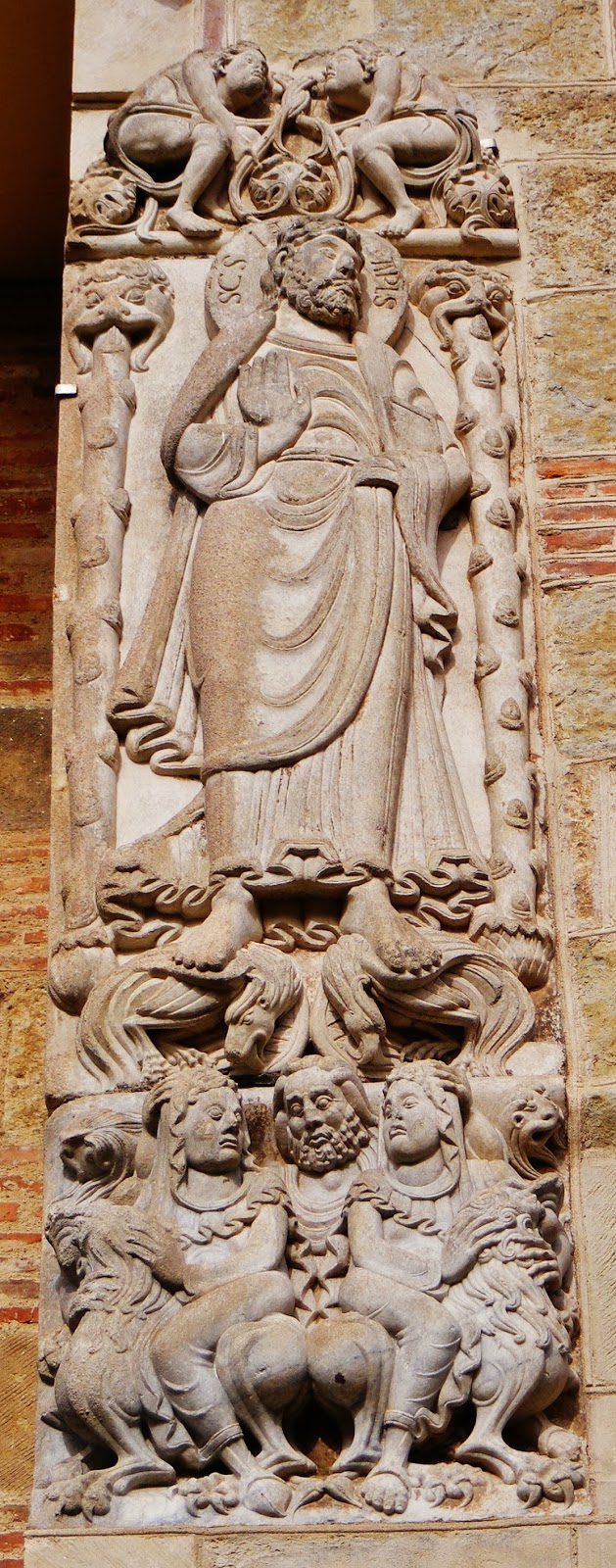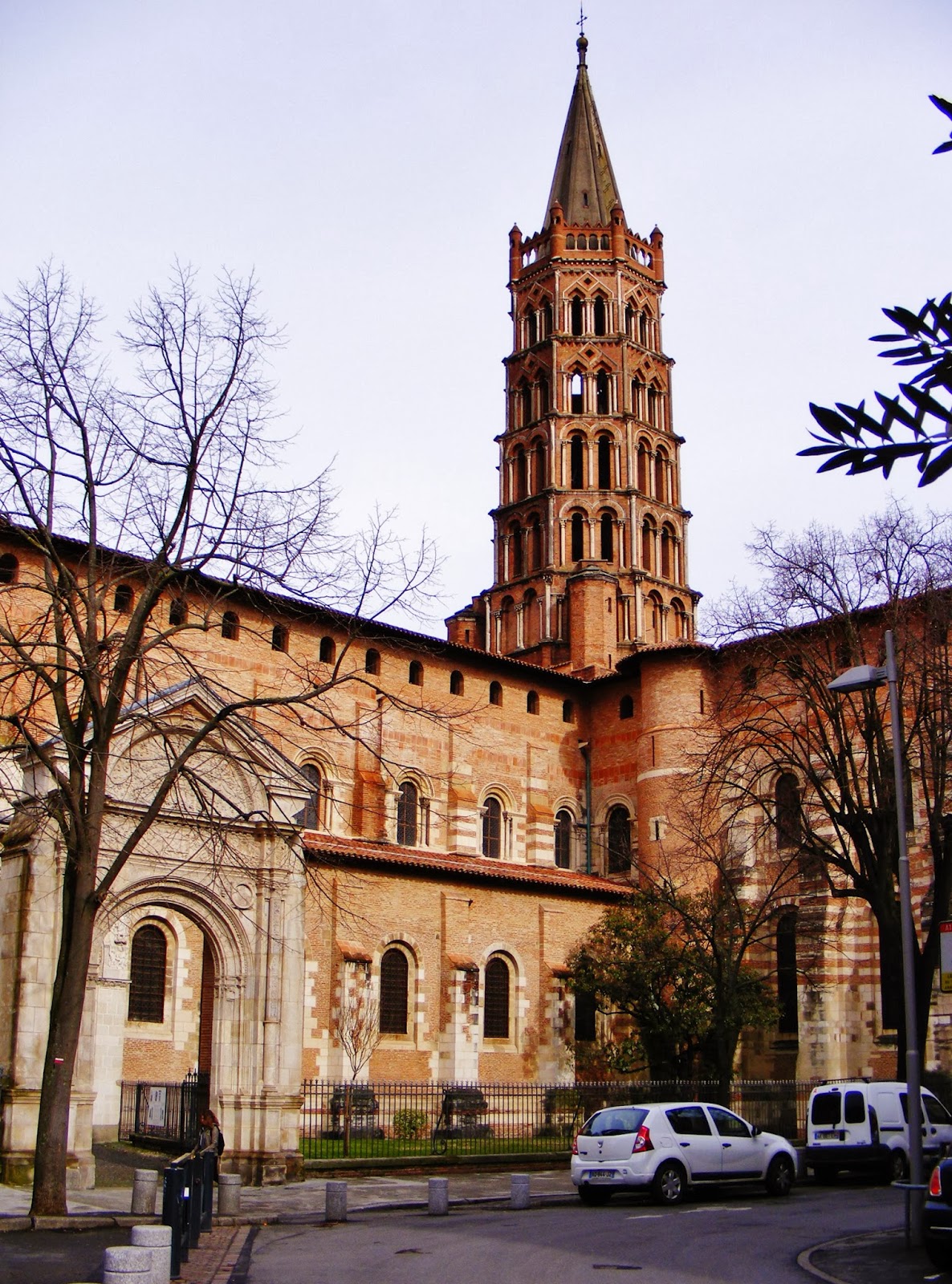Say “Toulouse” and most people think “Airbus”.
Partially because of that, it’s now the fourth largest city in France (after Paris, Lyon and Marseille, in that order). It’s the center of the country’s aerospace industry, the place where the Galileo spacecraft’s positioning system was developed, as well as the Ariane rocket, and it’s the headquarters of France’s section of the European Space Agency.
 As futuristic as all that sounds, Toulouse is also home to one of Europe’s oldest universities (founded in 1229), which gives the city deep roots.
As futuristic as all that sounds, Toulouse is also home to one of Europe’s oldest universities (founded in 1229), which gives the city deep roots.Until the Revolution, France was broken up into provinces. Languedoc was one of them, and Toulouse was its capital, so the city is not a newcomer. Even before that, the Romans built it up from a mere military outpost into a city. When the Visigoths overran them, it became their regional capital. And when the Franks in turn took over from them, it became their capital. Its location on the Garonne River probably enhanced its attractiveness.
Under the empire set up by Charlemagne, regions were given considerable political leeway. Toulouse took full advantage of that, and its Count became rich and powerful. But with the Cathar uprising, Toulouse entered into conflict with France’s king, and the city finally was forced to become part of the realm under the Treaty of Paris in 1229, the same year the university was founded.
So much for history.
Toulouse is called la ville rose, the pink city because it’s built of adobe-style red bricks that glow pink in the setting sun. I’ve been there three times already, but always only in passing. Once overnight for my daughter’s national gym competition, when I flew down to surprise her - so I got to see the sports complex. Once again overnight, passing through in the car of a friend who was in a hurry to get somewhere else - so all I got to see was one arcaded square where the hotel and restaurant were located. And once more after visiting Albi, when I had programmed four hours to look around at last... but it was bitterly cold for the season and I was gloveless and not dressed for it - so I took an earlier train back to Paris and only got to see the train station and have a cup of tea in the café across the way.
Not very exciting, given all that’s on offer.
This time I’m going to do it though. This time I’ve traveled down just for that. (Well, that and to see my old friend who also finds the situation unacceptable and has volunteered to be my guide.) This time it’s February, but I have gloves and a Michigan-winter coat and boots. In short, I have The Right Stuff!
We start off with the Basilica of St. Sernin, because it’s the largest romanesque church in Europe. It’s been around since Charlemagne, who gave it some relics... and that turned it into a stop on the pilgrim’s road to Compostella. Daniel takes me to a side door, which just happens to be the one that has Saint James (of Compostella) carved in stone right overhead. The inside is vast, and hints at what Gothic churches will become. The columns are there, but there isn’t the light that Gothic engineering tricks already being developed will shortly afford. The windows are also much smaller than they will become in Gothic churches. And yet this romanesque church impresses by its sheer size.
 |
| St. James |
Next stop is Notre-Dame du Taur, a brick church with the typical flat fronton of the region. This is where the first university started, run by Jacobins, and it’s all that’s left of the convent complex. Unfortunately - perhaps - it’s lunchtime and the doors are locked.
Lunchtime is something my friend-and-guide approves highly of, as do I, and he escorts me down a side street to lunch at Old Man Louis’s. It’s an old-style bistro called Au Père Louis, where we are greeted warmly. The front room being half of the fun, the only seats left are at the bar, so we sit on our stools and watch the regulars over a glass of something Père Louis seems to have invented - or at least mastered: quinquina, sweet but not too, and syrupy thick, unlike anything else I’ve ever tasted.
The waiter/barman tries to talk Daniel into ordering just one cold meat plate to share instead of two, but to no avail. When they arrive, it’s obvious to me that there are going to be no “afters”, and that Daniel alone will be tucking into a second course. And that lovely meringued lemon tart is definitely out of the question.
 It takes me two courses to get through my “appetizer” alone: two types of ham (cured and dried), French salami, a huge hunk of pork pâté and the miraculous rillettes d’oie, a moist, spreadable, richer-than-rich pâté of shredded goose that is one of the wonders of France. (Be advised: pickles do not come with cold meats here, as they do elsewhere in France.) And all this - two plates, a main course, a bottle of wine and that Quinquina apéritif - for a third of the price such a feast would cost in Paris. Unbelievable. And unbelievably delicious.
It takes me two courses to get through my “appetizer” alone: two types of ham (cured and dried), French salami, a huge hunk of pork pâté and the miraculous rillettes d’oie, a moist, spreadable, richer-than-rich pâté of shredded goose that is one of the wonders of France. (Be advised: pickles do not come with cold meats here, as they do elsewhere in France.) And all this - two plates, a main course, a bottle of wine and that Quinquina apéritif - for a third of the price such a feast would cost in Paris. Unbelievable. And unbelievably delicious.We waddle out and down the street to the Hôtel d’Assézat, which, as its name does not indicate is not a hotel. Hôtel in French also means a private home of the mansion sort. Which this once was. My 1980 Michelin Guide Vert told me this was the most beautiful private building in Toulouse, and I’m sure it’s right. It also told me you couldn’t visit the interior, and that if I wanted a wonderful view of the roofs of old Toulouse I should ring the doorbell and ask the concierge for the key.
Well, guess what. We’re not in Kansas any more Toto; we’re in 2014 and a lot of Garonne has flowed under the bridge. It turns out this 16th c building is now a museum for a collection left to the city by a rich Argentine of German ancestry but raised in France. Shortly after my Guide Vert went to the editors, George Bemberg, having no heirs, decided to leave his humongous art collection to a French city. Paris played finicky; so did some other cities. Then Toulouse raised its hand and walked off with the prize, totally refurbishing this building as a showcase for Bemberg’s collection.
 |
| Bonnard, self-portrait |
We easily spend well over an hour in the museum. There’s way too much to see in one trip, so I guess I’m going to have to go back. (As for the tower, no one is allowed up in it any more, and believe me, I wheedled and pleaded.)
We head down to the Garonne River close by, to a square from which river tours usually leave, except that work is underway to salvage a tour boat that has sunk. That was fun for a while, in spite of my naval architect friend telling me they were doing it “in a very strange way” - and I’m sure he’s right. It gave me time to enjoy the beauty of the Pont Neuf bridge and the many students walking hand-in-hand. (The art school and a high school are nearby). We take a page from their book and stop at a café for a cup of something before heading home.
On the way back to the car, we again cross the main square of Toulouse, the Place du Capitole. The market that was there all morning has gone home, leaving the square looking even bigger than before, and all for pedestrians. The bronze croix du Languedoc - Occitan cross - in the pavement shines golden in the setting sun. Every sign on this square is golden, to give it a harmony... even the Golden Arches of McDonald’s are indeed golden here and not that awful yellow.
We detour into the Capitole itself, the city hall, elegant within its brick-and-stone walls. Frescos are everywhere and we go up the majestic stairway to see the salon where happy couples from Toulouse are married by the mayor. The view of the square below is even more striking from up here.
Then it’s back to the car, walking past the dungeon behind City Hall... all that’s left of the old 16th c Capitole. Night is falling. It’s dark before we get back to Saint Antonin Noble Val, with cheese from an amazing shop along the way. My guide has been excellent, but I know I’ll have to come back again to la ville rose. I’ve just scratched the surface of what Toulouse has to offer.
 Not to mention another meal at Père Louis!
Not to mention another meal at Père Louis!Jazzy singer Claude Nougaro wrote a song about his native Toulouse, which he loved dearly. Here it is, complete with a video show:
http://www.youtube.com/watch?v=0aBk54wMqjA






















